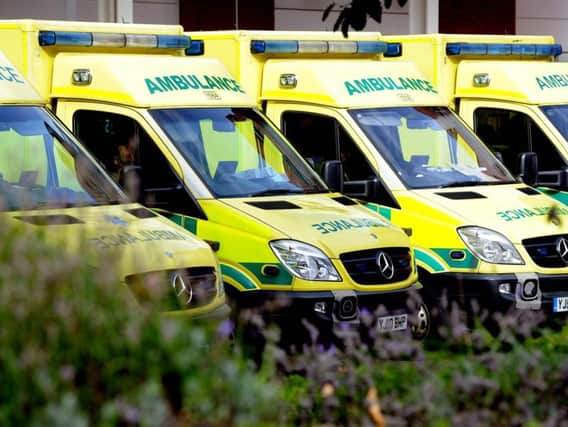Revamped 999 system aims to reach seriously ill patients even faster


The ambulance service has overhauled the way it responds to 999 calls in a bid to reach seriously ill patients even faster.
It comes after a trial elsewhere in the country, where academics found giving operators more time on the phone led to better care, with no adverse incidents reported in 14 million calls.
Advertisement
Hide AdAdvertisement
Hide AdLast week, The Post revealed how ambulances only managed to get to the most urgent 999 calls within eight minutes 68 per cent of the time last year, below a target of 75 per cent.
Those targets have now been scrapped, and the new standards will see paramedics aiming to reach the most serious emergency cases within an average time of seven minutes, and within 15 minutes nine in 10 times, and was endorsed by NHS England chief Sir Bruce Keogh.
“With ambulance service demand increasingly nationally by approximately six per cent year on year, the new system enables ambulance services to be much more stable and able to deal with unexpected events and peaks in demand,” a spokesman for the North West Ambulance Service (NWAS) said.
“In preparation for the go live date, we developed and rolled out a targeted, tailored training programme for our dispatchers, clinicians and managers across the trust, ensuring all staff were prepared to effectively implement the programme.
Advertisement
Hide AdAdvertisement
Hide Ad“The roll out went well and the system is now live in use across the north west.
“The central focus of this work is on the needs of patients and improving their outcomes, particularly those with life-threatening illness and injury.”
Biggest ever study shows system will be a success
The Ambulance Response Programme was an independently evaluated trial that lasted 18 months and covered 14 million calls.
And it found that, by giving operators more time to assess patients during the initial call, urgent conditions were identified quicker.In fact, there were no patients harmed, or adverse incidents, attributed to the programme at all, while ambulances did not arrive more slowly because call handlers had more time on the phone.
Advertisement
Hide AdAdvertisement
Hide AdIt said the ambulance service worked better during the trial, with less long waits for ambulances to arrive. It was the most extensive study of an ambulance service ever conducted anywhere in the world.
A report by Sheffield University found ‘strong evidence that the introduction of longer call assessment times produces clear benefits for operational efficiency, and this is translated into better response time performance for the most seriously ill patients’.
When looking at the changes to the script 999 operators follow, it said: “There is no evidence to suggest that patients, particularly with time critical conditions, are disadvantaged by this initiative, and the processes put in place to ensure early detection and dispatch to patients with cardiac arrest or potential cardiac arrest are working well.”
In relation to the changes in call logging, it said: “Overall, [it] appears to have brought a degree of stability to operational performance during a period of high demand, and significant operational challenges.
Advertisement
Hide AdAdvertisement
Hide Ad“Potential benefits may not be immediately apparent as there will be a process of continual review and readjustment of a whole range of function, that underpin operational delivery, before the right balance is found to maximise effectiveness.
“Clearer changes may become more apparent when this new model of service has been operating for a longer period.”
It also said the changes were ‘broadly welcomed’ by staff, though there were mixed views from frontline workers. “So although the reduction in the proportion of calls requiring an eight minute response was welcomed, there were some concerns around whether the right types of calls have been allocated to the right categories,” it added.Old system faced criticism for ‘stop the clock’ responding
Until now, 999 operators were forced to scramble paramedics within 60 seconds, which critics said was not enough time to make an informed decision over what sort of response was appropriate.
Advertisement
Hide AdAdvertisement
Hide AdSir Bruce said in a letter to health secretary Jeremy Hunt recently: “While this may have worked many years ago, it is hopelessly unsuited to modern medicine. A stroke patient, for example, will gain little benefit from a paramedic on a motorbike when what they need is an ambulance that can rapidly convey them to a specialist treatment centre.”
Cases were also categorised into ‘red’ and ‘green’ calls. Red one calls, where a patient had stopped breathing or their heart had stopped, and red two, less urgent but still emergency cases, had to be reached within eight minutes 75 per cent of the time.
But the clock is stopped when the first vehicle arrives, leaving what Sir Bruce described as ‘hidden waits’. He added: “A quarter of all patients who require hospital treatment have the clock stopped by a vehicle – often a motorbike – which is in fact incapable of taking them anywhere. There are few better examples of hitting the target and missing the point.”
He argued the old system saw multiple vehicles dispatched to the same patient in a race to stop the clock, and said 25 per cent of ambulances were stood down before reaching the scene.
Advertisement
Hide AdAdvertisement
Hide Ad“Every year hundreds of thousands of patients fail to get an immediate response because ambulances are dispatched in this wasteful and illogical manner.
“Correcting this anachronism would free up to 15,000 ambulance responses every week.”
Less urgent ‘green’ calls did not have a strict national target, though recommended response times ranged from 30 to 60 minutes, depending on the illness.
The old system also saw the ‘clock stopped’ if patients fell ill within 200 yards of a defibrillator, whether they needed the medical equipment or not.